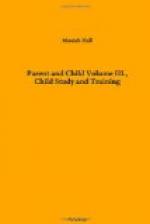The first great mental fact to note is that the infant is born with the capacity to respond to stimuli both from without and within. Touch the lips of the new-born child with the nipple or even the finger, and immediately the sucking instinct takes place; let a bright light shine into the open eye, and the iris at once contracts; plunge the little one into cold water or let it be subject to any bodily discomfort and at once the crying reflex takes place. The simple, direct responses to stimuli such as sneezing, coughing, wrinkling, crying, response to tickling, etc., are termed reflexes. The more complex responses which are purposeful and are designed to aid or protect the organism, such as sucking, clinging, fear, anger, etc., are called instincts. Besides the movements which are the direct result of stimulation, other movements more or less spasmodic and uncoordinated take place which seem to be the result of internal causes not easily understood.
The whole body is usually involved in these movements, and they are at first extremely random in expression. These are termed impulses and are undoubtedly due to the fact that the infant is a living, breathing embodiment of energy, seeking the means of self-expression. In other words, the infant is active from the beginning, and the slightest kind of internal disturbance is sufficient at times to turn loose an immense number of impulsive movements. This activity at birth is entirely uncontrolled. It seems that in contrast to reflexes and instincts which have prearranged bodily means of expression, the impulses must be subjected to a long period of training and education before they are capable of being controlled and transformed into that voluntary movement which is sometimes called will power.
The immense number and strength of these random, impulsive movements in the infant is in great contrast to the few, instinctive, unchangeable modes of action in lower animals. As already stated, most animals come to the world with the few movements necessary to their existence already provided for and so fixed that future adjustment to new conditions is practically impossible. The child, on the other hand, has marvelous capacity for adjustment to new conditions and presents, therefore, possibilities for training and education that have probably never yet been fully realized in any child.
The reflexes and instincts, however, are much more fixed and certain in their action than are the impulses. No matter what the training and education of an individual may be, he will sneeze, even in church, if the right stimulus is present; or he will cry and shed tears in public if the melodrama excites the proper nerve centers. When the sex instinct is fully aroused or the sentiment of love completely awakened, no one can foretell what the action of the otherwise sane person will be.




